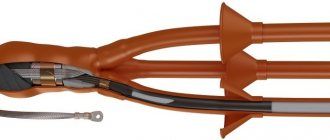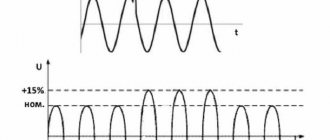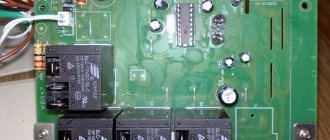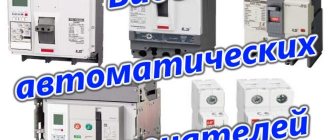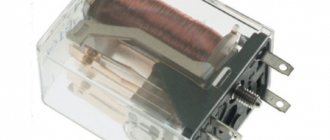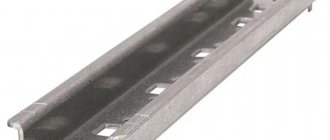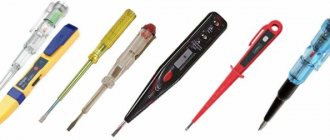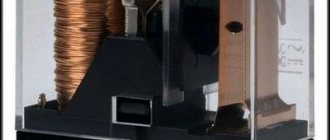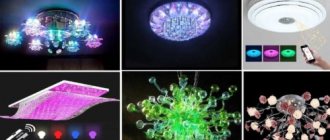What are electrical insulators?
Electrical insulators are a dielectric element of an electrical installation, structurally made of insulating material and reinforcing parts. The dielectric is intended for electrical separation, and metal structures make it possible to fix both the insulator itself and the conductors on it. Glass, polymer or ceramics are used as dielectric materials.
Purpose
Electrical insulators are designed for fastening busbars, wires, trawls and other current-carrying elements to the body of an electrical installation, support consoles and other structures. In addition, they insulate conductors when passing through walls, allow you to separate electrical installations from each other and other load-bearing functions.
Depending on the installation location, they are divided into internal and external. Also of no small importance is the voltage class for which a particular insulator is designed. Because of this, its design and certain technical characteristics will differ, determining the possibility of their use in certain electrical installations [ ].
Main technical characteristics
In accordance with the requirements of regulatory documents, the following characteristics are regulated for electrical insulators:
- Dry-discharge voltage is the value at which an electrical discharge will occur under dry surface conditions.
Insulator overlap - Wet discharge voltage – determines the same value as the previous parameter, but subject to rain falling on the surface. In this case, an option is considered when the direction of the jets is located at an angle of 45°.
Rice.
2. Insulator in the rain With such a flow of jets at an angle of 45°, which are indicated in Figure 2 by the letter A, maximum flow around surface B is ensured, and, as a result, minimum resistance to electric current is provided - from 9.5 to 10.5 kOhm*cm . This parameter is always below the dry discharge.
- Breakdown voltage is the value at which a breakdown occurs between two poles. Depending on the design, the poles can be represented by a rod and a cap or a busbar and a flange.
- Mechanical strength - checked by the load on bending, tearing or shearing of the head. In this case, the structure is rigidly fixed and a force is applied to it, gradually increasing to such a level of the highest stress in the material that leads to destruction.
- Thermal stability - tested by alternating heating and sudden cooling. Consists of two or three cycles, depending on the material and design. After which an electrical potential is applied, creating multiple discharges.
Checking technical specifications.
It should be noted that test procedures are not mandatory for all insulators produced at the plant. Only 0.5% of the batch is exposed to electrical, thermal and mechanical stress. It is mandatory for all insulators to test the flashover voltage for three minutes, at which spark discharges occur on the insulator.
The mechanical characteristics of suspended insulators must be checked. To do this, a mechanical load is applied to it within a minute, which is regulated by factory or state standards.
Such tests ensure normal operation of electrical insulators at rated currents and rated voltages in the network. And also, a sufficient level of reliability. In addition, some models are subject to periodic inspection during operation. Based on the results of periodic inspections and tests, they can be cleaned, rejected and replaced.
Passing
received their name for a narrower purpose. This type ensures the passage of current-carrying elements of power lines through various obstacles, such as metal transformer casings, walls of package transformer substations, switchgear, with their insulation from the ground.
| PASSING | |||
| with conductor | without conductor | polymer | |
| IP-10/630, IP-10/1000, IP-10/1600, IPU-10/630, IPU-10/1000, IPU-10/1600, IPU-10/2000, IPU-10/3150 | PMA 10 1UHL 2 | IPPU-35/400, IPPU-35/630, IPPU-35/1000, IPPU-35/1600, IPPU-10/4000, IPPU-20/2000, IPPU-20/3150 | |
The insulators we offer are approved for use in all energy systems as products that have passed certification in accordance with the requirements of JSC FGC UES.
Typical design
First, let's look at an example of a typical design using a sketch of a pin insulator.
Rice. 3. Sectional view of insulator
As you can see in Figure 3, the design includes ribs A and B. Which allow you to increase the electrical strength by lengthening the path for leakage current along the surface. Due to the different slope angles of the ribs, protection from precipitation is possible. So ribs A have a smaller slope, so they are most relevant for solid precipitation - snow, mud, etc. Because moisture can sneak underneath and significantly reduce the discharge voltage.
Unlike them, skirts B allow you to completely eliminate the possibility of moisture ingress in rainy weather. This provides a constant supply of resistance, which guarantees the breakdown voltage. In addition, skirts B are not afraid of ice freezing and can ensure normal operation of high-voltage lines in the event of a difficult meteorological situation.
To fasten the head of the rod, a B thread is provided, which allows you to secure the structure to the console or reinforcing hooks. In the upper part there is a groove G for fixing the wire. Additionally, the wire is tied with wire for more reliable fastening of overhead power lines.
Rice. 4. Bushing design
The bushing insulator has a slightly different design, since its task is not only to isolate the current-carrying busbar from the wall, but also to ensure the normal flow of current inside the insulator itself. Look, the tire is crimped on both sides with an aluminum cap to secure it securely on the outside. Inside, mechanical fastening is carried out using a sealant, which in addition prevents the entry of pollutants and aggressive substances. Also, for the convenience of attaching wires or busbars, an additional petal can be installed on the cover itself, as shown in Figure 4.
A protective shell made of silicone rubber prevents electrical breakdown along the surface from the tire to the flange. Insulation against breakdown of internal elements is carried out using a fiberglass pipe, which is placed inside a ribbed jacket. More detailed information about the parameters can be obtained from the model designation.
Designations of insulators
The labeling of each product contains information about its type, material and other characteristics. Look at an example of marking for insulator NSPKr 120 - 3/0.6 - B.
- The first letter N indicates the purpose of the model, in this case N - tension. It can also be K - console, F - fixed, P - suspended.
- C - indicates that this is a rod insulator.
- P is an insulating material, in this case P is a polymer.
- K – outer coating, in this case silicone rubber.
- p – index indicating that the protective shell is ribbed and solid.
- 120 is an indicator of the normalized breaking force in kN.
- 3 – voltage class of overhead line wires for which it is used.
- 0.6 – indicates the length of the leakage current path, measured in meters.
- B - indicates the type of engagement.
Supporting
designed to isolate wires from supports. Support insulators work in compression, tension or bending and are divided into pin insulators (mounted on support pins or hooks) and rod insulators, which are attached at the base with bolts or screws.
| SUPPORT | |||||
| PIN | ROD | ||||
| PORCELAIN | GLASS | POLYMER | PORCELAIN | GLASS | POLYMER |
| ShF 10G, ShF 20G, ShF 20G1 | ShS 10, ShS 20, ShTIZ 10, ShTIZ 20 | ShPU-10, ShPU-20, ShPU-35, NP-18, TP-20, ONShP-10-20, ONShP-20-10, ONShP-35-10, ONShP-35-20 | IOR10-7,5-III-UHL, I4-80 UHL, T2 | ISHOS-10-8 (S4-80 II), ISHOS-10-20, ISHOS-20-10 | OSK 4-10, OSK 6-10, OSK 12.5-10, OSK 8-35, OSK 10-35, OSK 12.5-35, OSK 10-110 OTK 20-110 STAN-6-110, STAN- 10-110 ONShP-10-20, ONShP-20-10, ONShP-35-20 IORP-10 |
For fastening insulators, we offer as components:
HOOKS type KN-16, KN-18, KN-22, KV-22. CAPS type K-4, K-5, K-6, K-7, K-9, K-10, KP-16, KP-18, KP-22.
Classification
To ensure reliable power supply and maintain the maximum level of safety in each specific case, insulators of the appropriate type and design must be used in electrical installations. Depending on the criterion, several parameters of their classification are distinguished.
By purpose
Depending on the purpose, the following types of insulators are distinguished:
- Stationary – used for mechanical fastening of current-carrying rods or busbars in switchgears. Depending on their purpose, stationary insulators are further divided into support and bushings. Thus, support insulators act as a base on which busbars are attached in cells or supporting structures. Bushings allow you to pass a current-carrying element through a wall or ceiling of a room.
- Hardware - have a similar purpose to stationary ones, but in relation to any devices. For example, hardware insulators are widely used in rectifier installations, power devices, complete substations, installations of high-voltage devices and other units. Look at Figure 5 for an example of its use, where it is designated AI.
Rice. 5. Example of hardware isolators - Linear – used for external installation under high-voltage lines or busbars of open switchgears. A distinctive feature of linear insulators is the presence of wide ribs or skirts designed to increase the path of surface breakdown in the event of precipitation.
According to the material of execution
Depending on the dielectric used, the following types of insulators are distinguished:
- With a porcelain body - they have high mechanical compressive strength, but are afraid of dynamic influences. To prevent the appearance of conductive channels due to the deposition of dust and dirt on the surface, the ceramic material is coated with glaze.
- Polymer insulators are divided into models that have elastic deformation and monolithic ones. They have a much higher resistivity of the material than porcelain. But the soft surface is more susceptible to contamination than glazed porcelain. In addition, due to exposure to ultraviolet radiation, the polymer deteriorates and loses its properties, so they are used for indoor installation.
- Glass electrical insulators are not as durable and are susceptible to chipping under dynamic influences. But unlike other materials, they are not exposed to aggressive reagents. They are lighter in weight and easier to maintain than porcelain.
According to the method of mounting on the support
Depending on the method of fastening there are:
Classification by mounting method
- Pin type (a) – they are attached using metal reinforcement and act as a support for overhead power lines, which is where the name post-pin insulators comes from.
- Suspended (b) - made with disc insulators, which are assembled into garlands, depending on the voltage class of the electrical devices connected to them.
- Rod (c) - have the form of a solid rod, which is installed as a support or suspended from reinforcement elements as a tension rod. Post-rod insulators are installed in switchgears for busbar insulation. Current-carrying parts are attached to their edges using cast-iron wings.
Difference in material
To consider the classification of types and types of insulators, you must first understand how they are distinguished. So, first of all, they are classified according to the material of manufacture:
- Porcelain.
- Glass.
- Polymer.
Porcelain ones can be called classics; they were used before even for external wiring in houses. They are usually white, but can come in other colors. These can be seen on various electrical installations. The advantage is that they withstand high compressive loads and have good dielectric properties.
However, they break and break. Hence the need arises to regularly check their integrity, and often this requires turning off the electrical installation and wiping off oil, dust and other contaminants. Another problem is their heavy weight.
Glass ones, although they are afraid of shocks, but to control their integrity a visual inspection is sufficient, which can be carried out without turning off the voltage. Currently, they are replacing ceramics in overhead power lines and as suspension insulators, including because they weigh less and are also cheaper to produce.
Polymer ones are used indoors, rarely outdoors, as an exception. You can sometimes see support insulators made of polymers on 10 kV overhead lines or other medium voltages, but rarely, or on non-critical lines. This is due to the fact that over time and under the influence of UV radiation they age, the internal structure disintegrates and their electrical and mechanical characteristics deteriorate.
However, for equipment that is available for regular maintenance and repair, they are often used. For example, these can be busbar support insulators in transformer substations and distributors.


